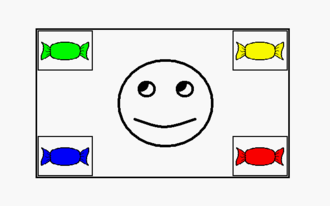Without balanced emotions, one's ability to interact in a social network will be affected in some manner (e.g. reading minds). In this part of the chapter some grave disorders will be presented- these are: depression, austism and antisocial behaviour disorders as psychopathy and sociopathy. It is important to mention that those disorders will mainly be considered in regard to their impact on social competence. To get a full account of the characteristics of each of the disorders, we recommend reading the particular articles provided by Wikipedia.
Autism
Autism is thought to be an innate condition with individual forms distributed on a broad spectrum. This means that symptoms can range from minor behavioral problems to major mental deficits, but there is always some impairment of social competence. The American Psychiatric Association characterizes autism as "the presence of markedly abnormal or impaired development in social interaction and communication and a markedly restricted repertoire of activities and interests" (1994, diagnostic and statistical manual; DSM-IV). The deficits in social competence are sometimes divided into the so-called "triad of impairments", including:
(1)Social interaction This includes difficulties with social relationships, for example appearing distanced and indifferent to other people.
(2)Social communication Autists have problems with verbal and non-verbal communication, for example, they do not fully understand the meaning of common gestures, facial expressions or the voice tones. They often show reduced or even no eye-contact as well, avoid body contact like shaking hands and have difficulties to understand metaphores and "to read between the lines".
(3)Social imagination Autists lack social imagination manifesting in difficulties in the development of interpersonal play and imagination, for example having a limited range of imaginative activities, possibly copied and pursued rigidly and repetitively.
All forms of autism can already be recognized during childhood and therefore disturb the proper socialization of the afflicted child. Often autistic children are less interested in playing with other children but for example love to arrange their toys with utmost care. Unable to interpret emotional expressions and social rules autists are prone to show inappropriate behaviour towards the people surrounding them. Autists may not obviously be impaired therefore other people misunderstand their actions as provocation.
Still there are other features of autism- autists often show stereotyped behaviour and feel quite uncomfortable when things change in the routines and environment they are used to. Very rarely, a person with autism may have a remarkable talent, such as memorizing a whole city panorama including, for example, the exact number of windows in each of the buildings.
There are several theories trying to explain autism or features of autism. In an experiment conducted by Baron-Cohen and colleagues (1995) cartoons were presented to normal and autistic children showing a smiley in the centre of each picture and four different sweets in each corner (see picture below). The smiley, named Charlie, was gazing at one of the sweets. The children were asked question as: "Which chocolate does Charlie want?"

Autistic children were able to detect where the smiley was looking but unable to infer its 'desires'. (adapted graphic from Ward, J. (2006). The Students Guide to Cognitive Neuroscience. Hove: Psychology Press. page 316)
Normal children could easily infer Charlie's desires from Charlie's gaze direction whereas autistic children would not guess the answer.
Additional evidence from other experiments suggest that autists are unable to use eye gaze information to interpret people's desires and predict their behaviour which would be crucial for social interaction. Another proposal to explain autistic characteristics suggests that autists lack representations of other people's mental states (mindblindness - proposed by Baron-Cohen, 1995b).
Depression
Depression is a disorder that leads to an emotional disfunction characterized by a state of intensive sadness, melancholia and despair. The disorder affects social and everyday life. There are many different forms of depression that differ in strength and duration. People affected by depression suffer from anxiety, distorted thinking, dramatic mood changes and many other symptoms. They feel sad, and everything seems to be bleak. This leads to an extremely negative view of themselves and their current and future situation. These factors can lead to a loss of a normal social life that might affect the depressed person even further. Suffering from depression and losing your social network can thereby lead to a vicious circle.
Psychopathy and Sociopathy
Psychopathy and sociopathy are nowadays subsumed under the notion of antisocial behaviour disorders but experts are still quite discordant whether both are really separated disturbances or rather forms of other personal disorders e.g. autism. Psychopaths and sociopaths often get into conflict with their social environment because they repeatedly violate social and moral rules. Acquired sociopathy manifests in the inability to form lasting relationships, irresponsible behaviour as well as getting angry quite fast and exceptional strong egocentric thinking. While acquired sociopathy might be characterised by impulsive antisocial behaviour often having no personal advantage, developmental psychopathy manifests in goal directed and self-initiated aggression. Acquired sociopathy is caused by brain injury especially found in the orbitofrontal lobe (frontal lobe) and is thought to be a failure to use emotional cues and the loss of social knowledge. Therefore sociopaths are unable to control and plan their behaviour in a socially adequate manner. In contrast to sociopaths psychopaths are not getting angry because of minor reasons but they act aggressively without understandable reasons at all which might be due to their inability to understand and distinguish between moral rules (concerning the welfare of others) and conventions (consensus rules of society). Furthermore it even happens that they feel no guilt or empathy for their victims. Psychopathy is probably caused by a failure to process distress cues of others, meaning that they are unable to understand sad and fearful expressions and consequently suppress their aggression (Blair 1995). It is important to mention that they are nevertheless able to detect stimuli being threatening for themselves.



